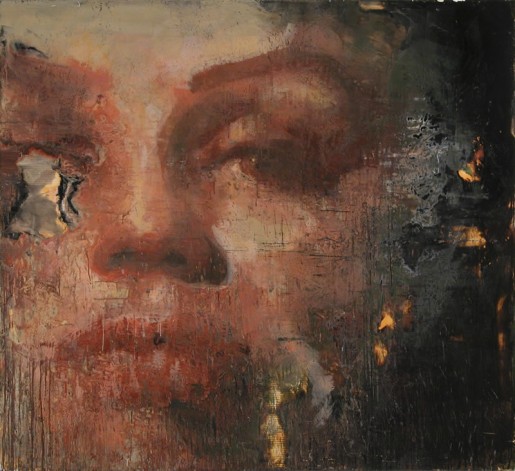
Tony Scherman
“Concrete structures with walls designed to be rendered white make bad ruins…”
Nikolaus Pevsner
Architectural Review, 1959
“It was the first post-humanist Biennale,” said Aaron Betsky, curator of the 2008 Venice Architecture Biennale, and went on: “If you follow the definition of modernism it is the production of completely rationalised states. Rem shows the elevator, the staircases, everything that moves you around. It creates completely reproducible and optimised space that is the same all over the world. What are eliminated, as Rem said, are not only the architects but also people. If that is where we are, and if that is what we have to build on, it is for me rather frightening but also revealing. How do we build then? And how do we go from there?” “The first thing to think about for the future is to kill the baby boomers. It is to kill David Lynch and his generation of permanent plagiarism to produce their own shamanism value. We just have to stop. Baby Boomers, it‘s time for you to die. You are useless now”, suggested François Roche.”
Uncube Magazine
June 2014
“The terror of the ‘evil eye’ is present in all societies in which a propensity for collective violence continues to ferment, and is manifest as an apparently rational fear of the indiscreet observer, of the prying or penetrating gaze…”
Rene Girard
Mark Wigley has written very cogently about role of ‘white’ in 20th century fashion and architecture. He makes the point that white is always a layer. What this suggests is that the presentation of revealing is not really revealing anything more than a different layer. But it is ‘read’ as naked, unclothed. I’d suggest this is consistent with how a lot of manufactured narrative and corporate cultural product present themselves. The kitsch model for *depth* is usually imagined as undressing, down to your undergarments, and finally, the core naked body. The core body is synonymous with truth, and more, with fact. One reading of 20th century architecture sees the idea of transparency as the driving motif, and clearly transparency has become a metaphor for political honesty over the last forty years. Again, however, the problem is twofold. One, nothing is ever completely transparent, and two, transparency as a spatial model for reading truth and fact, is highly problematic. This excavation idea, an architectural dig, to *unearth* the long forgotten or hidden wisdom brings with it several unfortunate colonial associations. But more than that, such images and metaphors raise questions about how to define the secondary terms involved.
If one thinks of painting, and notions of depth, the spatial model is diluted some. Depth becomes shorthand for complexity, or even for technique. But, its still there. The idea of unlocking something hidden, or captured. Again, there are curious and slightly disturbing echoes at work. In theatre, say, a narrative may have complexity, in theme, in form, and in a sense the idea of depth is mediated further. In film, depth has increasingly, I think, been attributed to work that is manifestly shallow. Or focused on surface gloss. The recent Under the Skin (Jonathan Glazer director) is a film that wants to be read as having depth. It parades an entire shopping list of pseudo arty ‘affects’. Pure black cyclorama, pure white cyclorama, and an odd computer noise soundtrack. ‘Verite’ elements, and the frisson of shooting in working class Glasgow. I only mention this film (Armond White has effectively described it already (here: http://www.out.com/entertainment/armond-white/2014/04/17/scarlett-johansson-exterminating-alien-glazer-under-skin-promotes-sexphobia ) because it serves as a model for the artist’s shallow interpretation of the idea of ‘depth’, so to speak. The shallow deep. Now this is a film with an 86% approval rating on Rotten Tomatoes. What does that say?
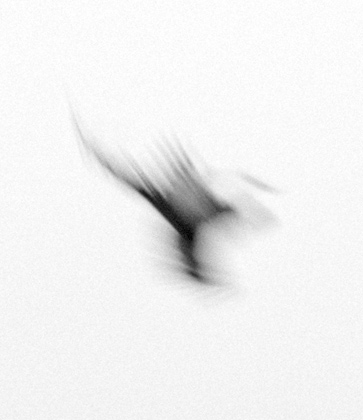
Trine Sondergaard, photography.
Now, the shedding of clothes, in an effort to get deeper, and closer to the truth, also suggests hygiene. The naked body is de facto a clean body. One might ask why? Well, in one way, the naked, the unhidden, the unclothed, is somehow stripped of representation. But there are several contradictory readings here. Whitewashing something suggests obscuring the truth, suggests cleansing the bad deeds of someone or something. It tacitly implies the putting on of a layer. Mark Wigley points out here that the history of clothing contained paradoxical readings of “white”. He wrote; “The linen garments that were once hidden beneath layers of clothing slowly came to the surface to represent the condition of the body that they no longer even touch.”
It would be interesting to examine the history of bathing, in relation to images of cleanliness. Wigley quotes Georges Vigarello, who says the history of cleanliness “consists in the last analysis, of one dominant theme: the establishment in western society, of a self sufficient physical sphere, its enlargement, and the reinforcement of its frontiers, to the point of excluding the gaze of others.”
What is crucial here is that for Le Corbusier, and other architects of the early 20th century, the building was tacitly equated with a body. The body of the building. This is partly Wigley’s point, that this new white surface liberates the eye. It also creates a new sense of space. It is interesting to follow the use of whitewash from earliest times and its disappearance following industrialization. For Corbusier, there was a primal truth in the crushed stones, diluted with water, and made into lime wash. It was a sign of something civilizing. But I want to go back at this point to the idea of depth, again. For even here, with the use of white, there is nothing neutral or passive. White cleans, purifies, or stamps with moral rightness. The body is now being eliminated in post modern architecture. Patrick Schumacher (director of Hadid’s firm) said architecture is now a form of communication. This is a mystification of what building is, for it hyposthesizes a world of immaterial absoluteness, in which everyone thinks they are outside, looking in, when in fact the opposite is true. Francois Roche suggested an image of goldfish staring out of their glass bowl.
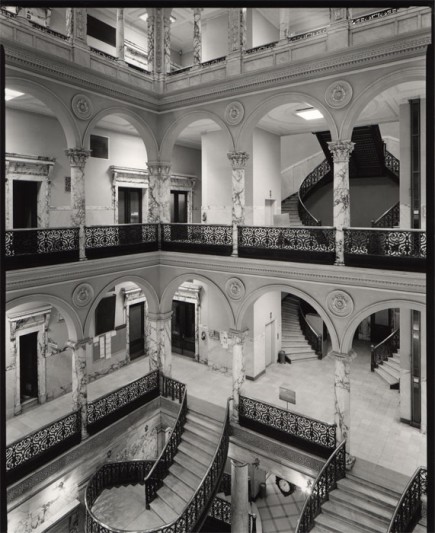
Monroe County Courthouse, Rochester NY, Jim Dow, photography.
Le Corbusier saw his new architecture as the emergence of the essential. That the discarding of decoration ends with the purity of the outline and proportion of the structure (i.e. the truth). Now Le Corbusier also used a telling example, the ballerina in a white dress, which he associates with the sleek white lines of an ocean liner. Here we have theatrical space coming to the fore. Ocean liner as symbolic theatre stage. Now Adorno suggested the question of depth was related to essence and appearance. For Adorno, only the positivists rejected this question. Psychoanalysis has as its default setting, a distinction between essence and appearance. We dont know why we do what we do, often, but the material historical world has shaped much of this, and in a sense then, what we do is the appearance of those shaping forces. Forces that can be looked at as essences. This is just the form of thought that philosophy has followed. Hegel used the term “empty depth”. And I think in a sense, this is the state of much post modern thinking. For there is a positivist inclination in certain strands of post modernism (especially in the visual arts). There is also the other variety of corrupted depth (the anti anti-imperialists for example) that invariably results in various kinds of tautology.
But back to the idea of white and Le Corbusier’s assault on the idea of decoration and ornament. One point worth looking at here is that Le Corbusier (as Wigley points out) saw his polemical theories as a corrective against fashion (in women’s clothes). And this was typified by Art Nouveau. I suspect it was a reaction to a certain fad of Art Nouveau which had engendered a lot of amateur decorators. And there was a certain suffocating quality to the worst of that movement. So there is a certain male ethos in play with the white cleansing. How far to take this observation, I’m not sure. But it is worth seeing one stage beyond (deeper) past architectural design as that of engineering, and that was experienced as exclusively male. Now fashion is also, clearly, a mediating force for thought, and expression. It is anxiety producing. Wigley points out that fashion has come to penetrate all aspects of architectural practice; from “…architects appearing in advertisements for clothing designers and stores, the featuring of architects and buildings in fashion magazines, fashion supplements in architectural magazines, …the role of architecture in fashion shows, the actual *look* of the architects…the ongoing transformation of the language of architects and critics,…”. Now, Wigley adds (he wrote this in 1995) that the conservatism of the discipline is its complicity with the economic model in play, as is fashion, especially as expressed in haute couture, and the elite ownership class that participates in any mobilizing of activity. I suspect that since 95, the role of Hollywood has actually increased, and the power of agents and PR firms to embed celebrities from all fields (sports, films, politics etc) into fashion/architecture has increased threefold. Wigley correctly argues that the entire idea of postmodernity is based on “interior values displaced onto seemingly ephemeral exterior surfaces.” And “the fetishistic obsession with surface at the expense of (what was once understood as) a concern for material and economic structure.”

Justin Allen
I remember when video artists started working with installations in galleries. And it seemed curious to me at the time, since I was working in theatre, that this affect-less blank presentation of self was de rigueur. If *modern* theatre started back with Von Kleist, to Buchner, to Beckett, there was always running throughout an incorporation of music hall comedia, marionette theatre, and clown shows. And of vaudeville. The gallery installations eschewed this history, the better to distance themselves from ‘performance’ per se, but also from the idea of a theatrical artifice at all. There was a sort of weird sexual and emotional cleansing going on. Now, there was also a sharing of something worth examining in both the video and installation artists that came up in the 80s, with those architects who came to prominence in the 80s as post modernists, and to clock the influence of the culture industry and fashion in all this, and then to compare and contrast with the thread of modern theatre, say, from Beckett and Genet to Pinter and Grotowski and Peter Brook. That lineage in theatre has suffered a slow down since the early 70s I think. So, who has come later…the answer would be the rise of Robert Wilson, and performance art, monologue-ists, and the late work of playwrights who started in the mid 70s. Wilson is to theatre what Tschumi and Koolhaas are to architecture. The removal of the human.

Torten Estate today, Dessau, Bauhaus plan and design, 1928
So, there is a question here, and it has to do with control, and with authority. And both have to do with sexuality. The attacks on fashion, from Loos to Le Corbusier, and certainly to Sigfried Giedion, were partly driven by an insecurity about the encroachment of the feminine. Fashion, and more, decoration, was ‘feminine’. And the white walls that cleansed the eye, also restored masculine order. In fashion itself there was a fear of fecundity and the disorder of sexuality and reproduction. In one sense, the art of many installation and concept artists shifted toward fashion, to elitism, while another branch turned political and propagandistic, and throughout all of this was a new economic interaction with culture. Now there was also, in the best of video installations a necessary purification of “entertainment” and kitsch in mainstream theatre. And throughout art criticism came a deepening fear of this question of ‘essence and appearance’. Julian Stallanbras, as an example, erstwhile leftist art critic, can write of “Freudian and Lacanian models, widely discredited in other fields”. What might that mean? I mean seriously, to be able to write that sentence suggests the performance of one’s own analysis in public. But the point is, there is both a gendered and a sexual set of readings in play. And the flight from Freud dovetailed with the fear of the messy and anarchic sexuality of the music hall, and proletarian folk art forms. There was always a certain narrative investigation of scatology and sexuality, from Rabelais to Pasolini to Genet, that was ‘not’ about purification. It was am embrace of an earthy sensuality. The flip side ran away from the social in the interests of meditative reflection, and satori of some variety. But what happened, within more mainstream currents of artistic expression, during the 1980s, and onward through today, was the inscribing of the fashion industry on the selling of and branding of culture. As Hollywood sunk further down into a Pentagon funded orgy of violence, the flip side of the same coin was the funding of fashion’s style codes and presentation by the same people, really, who make money from Pentagon generated conflicts. Fashion week, and Vogue and the globalized industry of clothing (mostly) women, can be seen to suggest suspended adolescence, and an emaciated child or toy on which one hangs garments. The spectacle of Fashion Week, whether Milan or New York or Paris, is half parody of a slave market, and half coronation pageant. It is the re-enacting of class subjugations and class hierarchies.
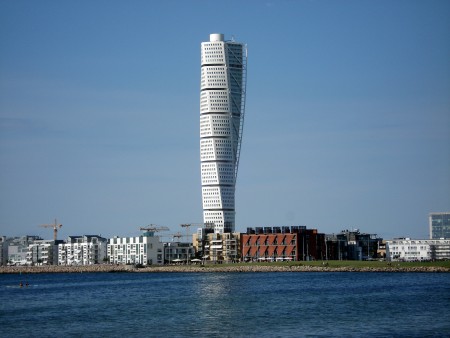
Turning Torso Tower, Malmo, Sweden. Santiago Calatrava, architect. 2005
The appearance of clothing, as haute couture, is really the unconscious rejection of fertility and Dionysian mysteries. The architectural unconscious, has to have something to reveal, even if only nothing– or emptiness. Meaning, there has to be a mystery within or off stage, or out of frame. I think there is a kind of conflating of principles at work in how a lot of Le Corbusier, and even Gropius’ architecture is read. There are perspectives in which the eye is led around corners, things wrap instead of stopping. The white wall in Le Corbusier is (to quote Wigley again) a moral code, not a fashion statement. Gropius too, had Uptopian dreams. The shift that took place in sensibility from around 1980, was an adjustment to the status quo, to power and hegemony. There was none of the Utopian thinking of Gropius or Loos, or Le Corbusier.
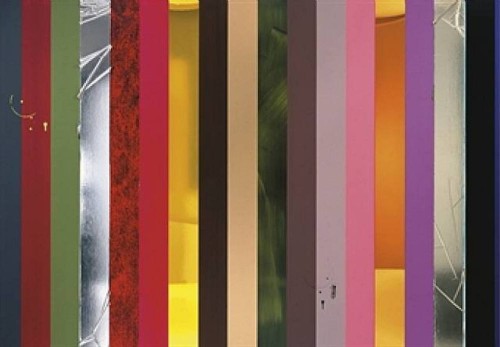
Anselm Reyle
This entire discussion of white in architecture, however, speaks to the emphasis on the optical. And perhaps this takes us back to essence and appearance again, and the discussion of depth. The digging, the excavating, to unearth the treasure. The treasure map has retained amazing durability as a trope in narrative, and for obvious reasons. Depth implies a center, or a bottom. But depth before all else suggests a history. The constant *present* of today’s architectural white is the result of white wall as exterminator; the destroyer of history (as a threat) and the reflective gloss that will tend to reflect back the star architects brand. Depth also implies dreams. But there has been a sort of secondary war on the oneric in art. Dreams need colonizing and occupation. They need to be disciplined. It is interesting to note Walter Benjamin’s distrust of Le Corbusier’s notions of transparency. Also as Bataille wrote: “The storytellers have not imagined Sleeping Beauty would be awakened covered by a thick layer of dust…”. The denial of depth is, finally, a refusal to see the logic of domination at work. The migration of attention to the surface of things serves to help people turn away from the infiltration of their daily lives by surveillance, data gathering, and CCTV. You cannot dream properly under surveillance. This was the paranoia of writers like Philip K.Dick, and it echoes the Hindu myths of ‘the dream dreaming us’. Depth is always linked with mimesis. If artworks, including in a specialized sense architecture, oscillate between reification and reconciliation, and buildings are (per Adorno) crystallizations of history, this is then modified in the post modern period. For the post modern is always mimicking the totalitarian strategies of supervision and containment. The stopping of mimesis. It is Post Modern architecture (and most of what is called post modern art of any kind) that has incorporated the commodity form, and commodity material in a new way, in the acceptance of and fascination with kitsch, and through this an expression of space, imagined, or at least marketed, as global.
“Of all the arts, architecture is the closest constitutively to the economic, with which, in the form of commissions and land values, it has a virtually unmediated relationship. It will therefore not be surprising to find the extraordinary flowering of the new postmodern architecture grounded in the patronage of multinational business, whose expansion and development is strictly contemporaneous with it. Later I will suggest that these two new phenomena have an even deeper dialectical interrelationship than the simple one-to-one financing of this or that individual project. Yet this is the point at which I must remind the reader of the obvious; namely, that this whole global, yet American, postmodern culture is the internal and superstructural expression of a whole new wave of American military and economic domination throughout the world: in this sense, as throughout class history, the underside of culture is blood, torture, death, and terror.”
Fredric Jameson
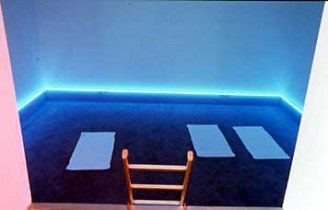
Dominique Gonzalez Foerster
“Panopticity is an impossibility, and pyrrhic attempts to attain it inevitably inflict disappearances and injustice…the messiness of the everyday disorders, both theoretically and experientially…and when the order in question is a would-be panoptic one, imposed from on high for the purpose of instrumental control and even gross exploitation, is… disordering a bad thing?”
Steven Flusty
The neo liberal globalization agenda flourishes in what Foucault called ‘impossible space’. The Euro centric tendency toward a Panoptic point of view, from on high, is pronounced in all discourse, and it is embedded in how we interact with space. How we articulate and describe it, and how we experience it. I am often engaged about my tangents, and I think its important to make clear that my tagents, my digressions, are both intentional, and accidental, in a sense. Intentional because one of the coercive tendencies of instrumental thinking is the policing of and enforcing of a narrowness of topic. To keep topics and disciplines from mixing, much like cities keep classes from mixing.
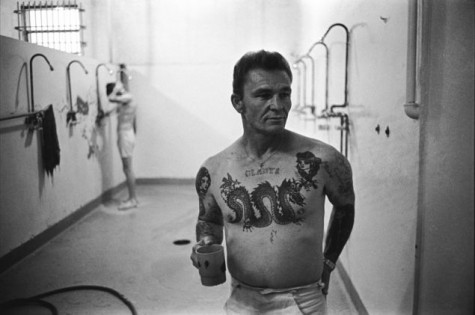
Bruce Jackson, photography. Cummins Unit, Arkansas Prison, 1975
All this brings me back to a kind of lost sense of space. In Hesiod, the implication is that creation takes place in a yawning gulf, where ‘nothing’ is…yet. Modification is about to take place. Chaos is not disorder, but emerging order (as Edward Casey put it). By Genesis, the emphasis is on separation. Earth from sky, or sea from sky. Followed by Night from Day. So, these early creation stories; Hindu, or Jain, or Zoroastrian, or Navajo, all express something of a tension, that between Night Sky, and Earth. The primordial space is always a precondition for genesis. Mirroring and rivalry. The point is, for the purposes of this posting, that a narrative for creation myths finds that narrative taking place in space. In the Mayan Popol Vuh, there is a description of calm water, alone, and “nothing existed”. Except clearly something did, but that doesn’t matter, for *nothing* has to be there, and such acceptance of contradiction seems worth contemplating. The theatre, the stage, is always an echo of these primordial spaces of genesis. The narrative modification, like the spatial modification, implies people. Or a person, anyway. Enter stage left.
This is an important aesthetic consideration. For today, culture is mediated by a globalized Capital and proprietor class whose goal is the disciplining of the masses, the domination of resources and the maximizing of profit for corporations and international financial institutions. And memory of space, those archaic trace elements (Emory School of Medicine, in Atlanta, has done research on rat DNA and the inheriting of phobias…but I digress) that I suspect are part of all creative expression, are a de-facto target of a system devoted to profit. The divisions in society, caused by this desire for accumulation and control by the investor class, is now the essential material used in how society reproduces itself. So, the ways in which one ‘sees’ (or doesn’t) the world one moves through is crucial as a precondition for changing it. And the way we are encouraged to ‘see’ it is as a display case, or a prison yard, or through bureaucratic yellow lines on the floors of our imagination.
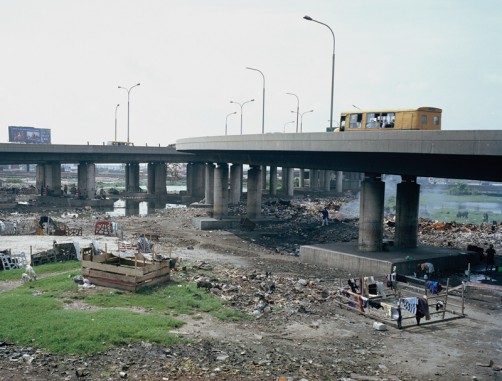
Paul Seawright, photography.
This question of depth is significant, for the mediation of daily life goes on unnoticed. Fifty years ago Adorno wrote about leisure time, and the selling of pseudo activities, hobbies, DIY projects, etc. That they mimicked industrial production and how recreational sports activities prepared the participant for the physical abuses of his or her job. Today much of this has transferred to the psychological realm, but still, there is something disturbing about the bourgeois health club, climbing walls, treadmills and the always attendant merchandising of these activities. The false mountain wall. Disneyland. Now, work outs have doubled aspects because, obviously, exercise is important and even perhaps profoundly crucial, but the narrowing of the experience to a Disneyworld environment complete with authoritarian personal trainers, suggests a co-opting is taking place. The personal trainer is like the chef in high end restaurants, watching the halibut en croute get just the right shade of brown. But again, space is being mediated. As society witholds more of actual nature from people, corporations build faux nature for people to purchase.

Sthala Sayana Perumal Temple. Mahabalipuram, Tamal Nad, India.
The limitlessness of open nature is a primordial desire. The security and warmth of certain interiors, in buildings or even nature, are also primordial desires. Today both are mediated. It was Derrida, actually, whose critique of institutional space was suggestive of philosophical categories; spaces of telos and origin. Of course, Derrida’s compromised project with Tschumi and Eisenman probably was to be anticipated. And then the unintended reactionary idea of architecture as an *event*. The deconstructivists were continuing the project of social ordering under guise of new imaginary person doing imaginary things. To quote Tschumi: “a new urban type results, based not on the static composition of building mass and urban axes but on the condition of the momentary and the constantly moving”. When Tschumi won the Parc de la Villete competition in 1983, the brief was to transform the former slaughterhouse and meat packing area, a hundred and thirty some acres, into a public park (for the 21st century, it was to be modern, progressive, and attractive to tourists…this was Mitterand’s Paris). The result is strangely disquieting and vaguely hostile. What Tschumi claimed, a park defined by people, open to interpretation, was in fact a reiteration of social oppression and the anxieties of urban life. Leave the city, come to the park, and experience the city again. Promise freedom but deliver the opposite. This is work (like Hadid and Koolhaas, and more than few others) that renounces human scale. The human is removed from the *event*. When Bachelard once analyed houses and interior space from a perspective of reassurance and the desires of a return to the womb, has under post modern architects become an annihilating dissociative antagonist. The unspoken (or rarely spoken) subtext here is business friendly. *Event* means shopping and business; arcades and places to eat, and t shirt stalls or cineplexes. It means property; buisness, is the center of the architecture, and the human has no ‘place’, and is passing through, stopping only to shop. The treasure map now leads to GAP.
http://www.dezeen.com/2009/03/11/yakisugi-house-by-terunobu-fujimori/
The above link is an article on Terunobu Fujimori, an ecclectic sort of outsider architect. Its a useful talking point because Fujimori is asking an entirely different set of questions, and employing a different visual grammar. Lacaton and Vassal’s social housing project in Mulhouse France is another kind of grammar, pragmatic, economical, and human scale. There are dozens of others that counter the grotesque mega-commissions that Norman Foster has inflicted on London, or OMA, or James Stirling or Michael Graves et al.
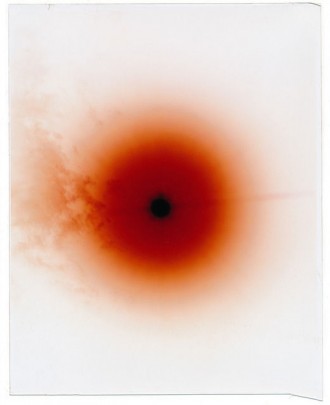
Nicolai Howalt
I started this with some thoughts on the evolution of architectural ideas following on Le Corbusier. And on space, and haute couture. There are parallels in visual arts, which I wanted to just add to. If we live in a landscape of *events*, of kinetic shopping grids, then it makes sense some of the best visual artists today are recuperating the sense of place, and demanding the optical be de-programmed. Artist as anti-Scientology deprogrammer. The cult of starchitect has fallen in line perfectly with economic demands of globalization. I remember being in south India, and wandering into a temple in Mahabalipuram. Its a large temple, and was cool inside and in the courtyard. I stayed in Mahabalipuram for a couple of weeks and probably went to the temple every day, bought incense and chatted with people. There were never not dozens, several dozens of people in there at any given time but it never felt crowded. India, in the big cities always feels crowded. But this is a market town, about fifteen thousand people (this was 1992). I mention this because the spaces were human, there was a refreshing darkness inside, and one understood something of that for which temple life was intended. ‘Sadhus’ sat against walls, old and crippled beggars were there, and people fed them. There are the famous rock cave temples in that town, too, and today I’m told a Radisson resort has been built just outside the town, sadly. These ancient buildings invited, and situated one, allowed one to turn inward, and there were no perspectives in which one looked down.
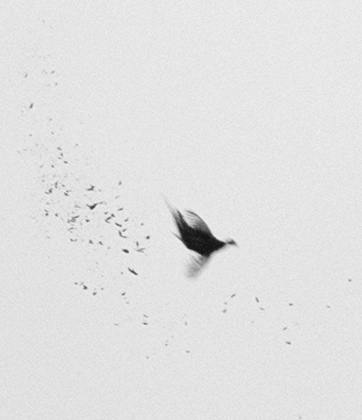
Trine Sondergaard, photography.
I posted two photos of Trine Sondegaard’s series “Dying Birds”. They are photos of birds being hunted, most at the moment of being shot. None of them are close up. All we have are imprecise blurred black specks against a white sky or light grey sky. They are a haunting photographic essay that perhaps says as much about a culture inured to killing as any example of which I can think.

I love this post ..
.”.hat this suggests is that the presentation of revealing is not really revealing anything more than a different layer. But it is ‘read’ as naked, unclothed. I’d suggest this is consistent with how a lot of manufactured narrative and corporate cultural product present themselves. The kitsch model for *depth* is usually imagined as undressing, down to your undergarments, and finally, the core naked body. The core body is synonymous with truth, and more, with fact.”
This seems to me the core of all the disguised ideology of modernism and minimalism…the association of subtraction and inquiry, truth and simplicity/distillation. The spectacle ideology tends this/same way, to abstraction and simplification in disguise as truth but really its opposite, the abolition of sythesis and plurality. This “purity” notion is certainly imperial!
I love PARC de LA Villette! Its truly popular usable public space! People use it…the real people of Paris …multicultural Paris..really use that park. Its
hey molly.,,,,,,,,,,,,,,I like your description, and I agree. The “association of subtraction and inquiry, truth and simplicity/distillation”. I think its increasingly not exactly subtraction, or rather, its a specific sort of subtraction, and this is why its so difficult to grasp. But your right (and its what I was trying to get at) with this idea of peeling away the layers to reveal the truth, but in fact you are peeling away layers to see different, carefully contructed ‘other’ layers.,..and this neutralizes the impulse of synthesis, and plurality (as you put it). Thats very crucial, and its deeply embedded now i think. Its also a way of (or its by product) killing any dialectical thinking.
as for parc de la villette……..well, yeah, I used to go the outdoor screenings there. Was great. And at least there is a lot of open space, Im not sure there isnt something creepy about the actual architectural part of it though. Thats an interesting discussion. I think its flourishes, as the only place TO go ….inspite of Tschumi’s design.
“The Euro centric tendency toward a Panoptic point of view, from on high, is pronounced in all discourse, and it is embedded in how we interact with space. How we articulate and describe it, and how we experience it. I am often engaged about my tangents, and I think its important to make clear that my tangents, my digressions, are both intentional, and accidental, in a sense. Intentional because one of the coercive tendencies of instrumental thinking is the policing of and enforcing of a narrowness of topic. To keep topics and disciplines from mixing, much like cities keep classes from mixing.”
And despite this observation (which I completely relate to and find very apt), one of the favourite catch words in academia today is “interdisciplinary.” There are “interdisciplinary arts” where artists use lots of different mediums/”forms,” often without really questioning where those forms came from and what it means to practice them in conjunction with each other (i.e. various forms of performance art, and some theatre with video, for example). There are “interdisciplinary studies” where people from separate disciplines are meant to study under the guidance of someone from an “outside” field. Interdisciplinary studies as I have seen it practiced in the institution, might be described as an additive process, rather than an expansive one. The mainstream conceptualization of “interdisciplinary” seems to be that we can borrow and learn knowledge from an area somehow separate from us—we can add other knowledge to ours. Whereas, I think a of interdisciplinarity as an experience of discovering the meandering, connected, pervasive, flow of ideas and subjects–a flow both bound by history, and yet somehow, with the aid of a mind, free from time… er… like, ‘clock time’…
I was on a panel a couple months ago, and the subject of discussion was “performance anthropology.” Now, I happen to find this topic deeply problematic, as most of the performance anthropology that I have either studied or seen, is not really “performance” but anthropology doing a “show.” However, what I wanted to share was a moment near the end of the panel that was rather telling, to me, about the state of interdisciplinary studies in the academy. We had gotten on a course in the conversation of asking: How do we practice interdisciplinarity? I listened and heard a mixture of fear, intimidation, and anxiety being expressed by some of the panelists in regards to studying someone else’s discipline. I got the sense that some professors and grad students were wary about knocking on the door of a professor from another faculty because they felt they could never understand the other discipline… they could never know “the canon” and therefore, they seemed to feel presumptuous about getting into someone else’s business. Still others seem to feel pressure to be interdisciplinary, like it is the “right” or “intelligent” thing to do, but they don’t seem to know why they’re trying to do it…
I was a little shocked at the intimidation and fear that I sensed from some of the panelists. I mean, I was thinking, ‘aren’t you curious?’ Isn’t the very fact that you can’t know the other discipline entirely, what makes exploring that discipline so compelling… that there is so much unknown? Is it not worth maybe looking stupid or asking simple questions, knowing that by taking such a risk, you might experience the world in a different way? …Well, okay, maybe ‘risking experiencing the world in a different way,’ is kind of terrifying, but I don’t think that was the kind of fear I was sensing. I was sensing a social fear. A fear of overstepping social bounds defined by western culture and played out in each institutional sphere, including academia. It is nice to respect the knowledge and wisdom a scholar might have from devoting years of study to their particular field, but why can’t curiosity about that field be a form of respect?
I was also surprised at the seeming ignorance of the fact that we are already interdisciplinary. I suggested to the group that intimidation of the “canon” of another discipline seems like a highly suspect feeling when everything in our modern lives is so invasive and invaded by everything else. My simplistic example was that I know how to drive a car, but do not really understand how a combustion engine works—I could live my life ignoring the connection between driving and physics or, I could follow and search for connections and find that the world is much deeper, larger, and pervasive/evasive than I can possibly know or understand. I think we are inherently interdisciplinary and connected. Compartmentalization and categorization is a cultural/societal tool for making a sort of narrative sense of the world. I don’t think it really has much to do with “truth.”
Of course, the institutions (corporations, media, government, etc.), want us to forget about how things are “mixing” and chaotic, and complicated. Thinking is dangerous. I was talking to a co-worker the other day, asking her a lot of questions about some experiences she had had, and she was asking me what I meant when I said that I wanted to do “research.” I started sort of trying to describe what I meant, but in what I thought to be a fairly simple way. At some point, she stopped me and said that I should ‘be careful who I talk to about these things.’ It was an odd moment, I was kind of thinking, “huh?” Why is it so bloody easy to seem controversial? And why are people so paranoid?
Speaking of paranoid, and the panopticon—we have a rather literal panopticon at my workplace. I work at a garden centre—well, the sign says that we’re a “greenhouse,” but I know better, it is really just a department store. All I do is move product into the store and out of the store again. The store is set-up in a series of high-ceilinged greenhouses. The structure consists of a ground-level, but at the very back of the store, along the wall, there is a second, narrow story where the offices are located with large picture windows overlooking the store below. The windows are very high and they afford an optimal vantage point for the management above for watching the workers and customers down below. On my first day working, the girl training me on such mundane details as how to pull the decorative plastic wrapping off of plant bases to water them properly—she turned to me and warned me that we weren’t really supposed to work in pairs very often, or talk much on the job. She tilted her head to the side, indicating the windows above and said in a lowered tone, “they’re watching.”
Much later, I learned from another girl that the boss has the security cameras hooked up to her cellphone and home computer so that she can always watch the store, even when she’s not physically present. I don’t really think I can describe how I feel about all this. I mean, on one hand, I think it is kind of funny. I think it is kind of funny how paranoid the management seems to be about their workers, but I also think that it is kind of unlikely that the management actually watch all that often (I mean, hell, this is a very BORING job we do). It is a little disconcerting that some of my co-workers feel the eye of management above them, and all around them. But at the same time, it is also NOT AT ALL funny. It’s odd to me that both management and workers seem to be so wary of each other upsetting the balance of an efficient, “safe,” working environment, when really the very structure of the business itself, and the product we sell, all encourage a way of existing that is alienating, objectifying and violent. It’s like… we’re busy planting a bomb somewhere, and when it is about to go off, we’re at some spa worried about whether or not the 2 for 1 deal is still on… I’m likely not explaining this very well… it just feels like there are two different consciousnesses going on at once.
I don’t know, I guess I have this feeling that we’re worried about the wrong things… Or at least, we’re worried about things that just seem to perpetuate my boredom, and alienation, and dehumanization (and yes, I DO feel that my humanity is at stake).
Anyway, it is interesting to note with the above description of the surveillance at my workplace, that neither worker nor management really have “power.” Both are sort of stuck in their own fears and anxieties because of their relationship with the other—or their Perceived relationship with the other level on the hierarchy. Sometimes I wonder if the world would feel less violent if people just stopped what they were doing more often and asked themselves, “Why am I doing this again?” Of course, the process of exploring that question can also be very violent, traumatizing, and chaotic; however, I suspect that this sort of violence could actually be the occasion for love and understanding… for (re)humanizing.
It seems to me that many people experience their environment through paranoia, anxiety, worry and fear—sometimes explicitly, and sometimes indirectly, beneath a shell of indifference and denial. It isn’t that I think these feelings are necessarily “bad” or “wrong,” or somehow hold us back from being better people—but I do think that there is a persistent lack of consciousness of these feelings, or at the very least, an inability to continually question and explore where they are coming from. I often wonder if people are fearful of things that aren’t ‘really’ threatening. That the causes of our fears and forebodings have been displaced by simplistic explanations and seemingly benign triggers that make us feel as though anxiety and paranoia are mere psychological diseases rather than physical/emotional clues to what is going on behind our conscious awareness…
@calla….thanks . Fascinating. You know, its a good point and worth getting into a bit more, this question of interdisciplinary. As you suggest the very idea of that term is a hint that its going to be proscribed…….and you’re right, of course we;ve all been already all the time interdisciplinary. But now, its presented as as this theoretical project, and in fact, it is doing the exact opposite. Like i used to feel about multiculturalism. Once a theatre (the field i worked in) started discussing multiculturalism, one knew that in fact things were being narrowed down. And this is an important idea, or realization. Im writing some on this now for the next post. Because interdisciplinary means carefully controlled ways of incorporating these ideas, these other disciplines….and its usually pre vetted disciplines anyway. You have to use them, and incorporate them, the *correct way*…..the synthesis goes missing, the dialectic is erased.
as for paranoid space.Its funny, I remember when close circuit cameras came on the scene. I was working …this is 1972………i was working in an adult book store and theatre. Back when they screen 16mm films. I worked midnight to 8 am. It was easy and mostly i read. Changed reels, read some more. But the boss, these low rent mafia guys came in and pointed to the camera above the entrence area. He said we’re watching you. I said ok. And once he left i went and checked the camera….because it didnt quite look right and sure enough it was an empty box. I wont confess to wrong doing here…..but……everytime he came in he would look at me, and say, good work step. Ive been watching you. I thought right…….this is the future. The pretense and the reality of surveillance.. Looking back, this was the stone age of surveillance…the dawn of the brave new world.
@ Steppling,
Ah, yes, I can see how the word, and the inferences around the word, “multiculturalism” would be such a headache… especially in the theatre. Sometimes, I find it very hard to really speak or write what I feel because so much of my vocabulary feels corrupted. For instance, when people ask about my research, I rarely, if ever use the word “interdisciplinary,” when it could, perhaps describe what I do. I hate to say that I research “a bunch of different things,” because that’s not really true either because everything seems to be the occasion for everything else somehow. Sometimes I will tell people that my research is “about everything.” That’s the most satisfying I can get to for now. Looking forward to reading what other thoughts you might have on “interdisciplinary” in your next posting…
As for your experience with the empty surveillance tape box, it sounds familiar. I also had a department store job about 9 years ago where management checked our lunch boxes or purses before we left the store after our shift to make sure that we hadn’t stollen any product on our way out. It’s funny how it is… Sometimes when I think about these dynamics, it seems as though I have a lot more power existing on the very bottom of the ladder in my workplace than I do at the top. On the other hand, one false move, and my economic and social existence could be greatly limited in THEIR world (“THEIR” meaning those “they’s” and “them’s” that people refer to in such phrases as, “they did a study…”). I don’t know. I’ve been thinking about this a lot lately too, and authority is a very strange thing…. It’s almost as though the word “authority” isn’t quite specific enough for me.
Also, thinking about your night job where you read for most of your shift, it sounds pretty great. I’ve had one or two people say, “why don’t you be a book reviewer,” but I’m thinking… that’s not really the kind of reading that I was thinking about doing. I mean, it might be more apt to say that I’m looking for the book to REVIEW ME. And that’s perhaps, a different sort of power–a power without “authority.”